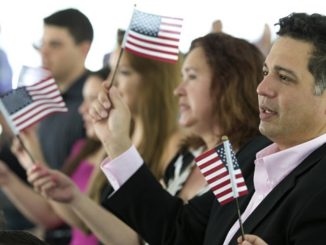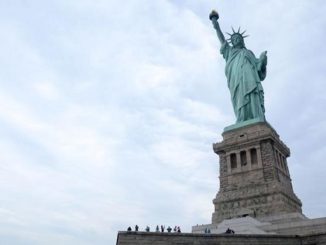
Trump’s new suspension on immigration, which he “announced” on Twitter late last night, should be seen through this prism.
In light of the attack from the Invisible Enemy, as well as the need to protect the jobs of our GREAT American Citizens, I will be signing an Executive Order to temporarily suspend immigration into the United States!
— Donald J. Trump (@realDonaldTrump) April 21, 2020
The new suspension has two rationales, according to Trump and White House officials: To continue combating coronavirus, and to protect U.S. workers amid a crushing economic downturn.
It will do neither of those things in any meaningful sense — which means that it won’t have the impact that Trump himself says it’s designed to.
According to the New York Times, Trump will sign an executive order that temporarily bars “the provision of new green cards and work visas,” which means the administration will “no longer approve any applications from foreigners to live and work in the United States for an undetermined period of time.”
It’s hard to say how much of an impact this will have. As the Wall Street Journal points out:
Administration officials said the order wouldn’t make substantial changes to current U.S. policy. Even without an executive order, the administration has already all but ceased nearly every form of immigration. Most visa processing has been halted, meaning almost no one can apply for a visa to visit or move to the U.S. Visa interviews and citizenship ceremonies have been postponed and the refugee program paused.
Immigration analyst Sarah Pierce notes that a lot will turn on details, such as whether this suspension applies to foreign nationals already here and applying for green cards or trying to renew visas, or if it only applies to people outside the country who want to come here, which has effectively been halted already.
“If they want to make official what’s already in place, it would make a flashy statement while having minimal impact,” Pierce told me, adding that if they did apply it to people here as well, it could be a lot worse.
We’ll see soon enough. But we can say right now that this isn’t a solution to the current problems we face on coronavirus, because those problems are rooted in the spread that already took place here. We are starting to bend the curve through social distancing — which Trump long resisted, and which he then tried to undo prematurely before backing off.
The problem is lack of testing
Right now the main obstacle to vanquishing coronavirus to the point where we can reopen the economy is the lack of a robust federal testing regime. Indeed, Harvard University researchers calculate that we cannot reopen safely until the current levels of testing have tripled.
It’s telling that only hours before announcing the new ban, Trump basically dismissed criticism of his failure to stand up a federal testing regime as a hoax. At Monday evening’s briefing, he mocked critics who, he said, thought they could “get him on testing,” claiming this was mostly “partisan.”
In reality, multiple Republicans have decried this failure. When GOP governor Larry Hogan of Maryland was recently asked about Trump’s claim that testing issues have been solved, he replied, “That’s just not true,” adding: “No state has enough testing.” That includes red states.
“This will do nothing at all to slow the spread of coronavirus in the U.S.,” Michael Clemens, a senior fellow at the Center for Global Development, told me. “The U.S. is by far the global epicenter of the disease. The horse has long ago left the barn on keeping it out.”
Nor is there reason to believe immigration more broadly is an important ally of the “Invisible Enemy” of coronavirus, as Trump claims. The Cato Institute crunched the numbers and found no correlation between coronavirus rates by county and immigrant share by county.
Meanwhile, liberal economist Jared Bernstein points out to me that positioning this move as a protection for workers right now completely misdiagnoses our ongoing economic calamity.
Joblessness is soaring because social distancing measures have deliberately placed the economy into a self-induced coma. And so, the jobless need direct and immediate financial help, not protection from labor market competition, and getting the economy going is directly linked to the need for far more expansive testing, so people can return to economic activities safely.
“The recession won’t be over until the economy gradually reopens, no matter what we do on immigration,” Bernstein told me. “We should be thanking immigrant (and native-born) workers for maintaining food production, health care, and every other essential service still in action.”
Trump views the virus as a foreign enemy
Still, Trump’s announcement is telling. His claim that this will help against the “Invisible Enemy” is another reminder that he has long seen coronavirus as mainly a foreign enemy.
That’s why he keeps hyping his Jan. 31st restrictions on travel from China as a singularly glorious act that proves he exercised decisive leadership all along. This, even though that one act didn’t do anything close to what he claims, and it took place before the string of disastrous errors that allowed coronavirus to rampage out of control to the point where getting a handle on it is obviously beyond his leadership capacities. The constant hailing of that one act cannot erase the catastrophe that followed.
The new ban is a propagandistic device designed to create the impression of action. It may succeed as chum for his base, but in a sense, that’s actually an admission of weakness:
This is Trump broadcasting to the world that he is seeing erosion in his base from massively fumbling the pandemic response pic.twitter.com/76v4rAOw17
— Dan Pfeiffer (@danpfeiffer) April 21, 2020
Meanwhile, Trump’s approval is sliding with the rest of the country, and this new scam won’t make his record of failure disappear, either. Nor will keeping out more immigrants address the consequences of that record of failure, because they have already been unleashed here.
No matter how hard they try, Trump and his propagandists simply cannot rewrite this set of realities out of existence.



